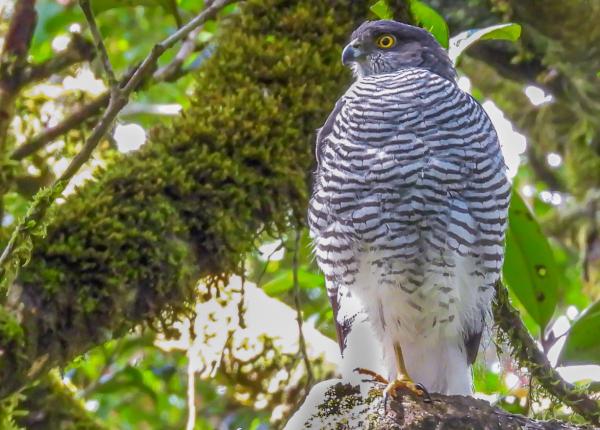Did You Know?
- The Madagascar Sparrowhawk is a poorly known species and would benefit from further study
How The Peregrine Fund is Helping
Though The Peregrine Fund doesn't work directly with the Madagascar Sparrowhawk, we have a very strong conservation program in Madagascar. Apart from the studies we conduct on several endemic raptors, we work hand in hand with the locals to help foster conservation on the island. Among our three conservation areas, we have assisted communities in planting more than 215,000 saplings to restore forests and establish plantations for food and jobs. We have fostered a professional staff of more than 30 Malagasy people, many with advanced degrees, who contribute scientific knowledge and lead their communities in conservation.
Additionally, our efforts in scientific research, habitat conservation, education, and community development help conserve birds of prey around the world. We also supply literature to researchers from our avian research library, which helps scientists around the world gather and share important information on raptor conservation.
Where They Live
This beautiful raptor is endemic to Madagascar. This means it is found there and no where else on Earth.
On Madagascar, it is found from sea level to 1,500 meters above sea level. It makes its home primary forest, dry and thorn forests, and gallery forests. Less often, this bird spends its time in degraded habitat or exotic tree plantations.
What They Do
This species has been observed flying low through trees and perching in areas where it is well-hidden by leaves. Outside of breeding season, the Madagascar Sparrowhawk primarily hangs out by itself.
Why They Need our Help
This species is categorized as Near Threatened by Birdlife. Though there is so much to learn about this species, some scientists believe that its population might be in decline. But, there is a chance that this hawk might be more common than it appears. This is because this raptor isn't very vocal and often perches out of sight, making it hard to observe and study. Sadly, there is a big chance that this hawk will be affected by future deforestation.
What They Eat
The Madagascar Sparrowhawk isn't picky when it comes to its diet. It will capture a plethora of different types of animals. While larger insects and small birds make up a large portion of this raptor's diet, the list of things it likes to eat doesn't stop there. It will catch reptiles, frogs, turtles, and rodents.
Nests, Eggs, and Young
Madagascar Sparrowhawks build their own nests. They will stake out a suitable site, usually high up in the fork of a large tree.
Then they will go about collecting twigs and sticks with which to build their nest, which is relatively flat.
The female lays a clutch of around three eggs, which are white and lightly marked with brown. After the young hatch, they will develop quickly. After around 37 days, the young will developed enough to fly from the nest. However, they will continue to sleep in or very close to the nest for a couple of more weeks. During this time with their parents, they learn how to hunt and avoid danger. After around 60–67 days they will become independent of their parents' care and will leave their natal territory.
Madagascar Sparrowhawk and the World Center for Birds of Prey
Though the World Center for Birds of Prey is far away from the Madagascar Sparrowhawk's range, the center still offers fun ways to learn about this raptor, the work we are doing in Madagascar, and other birds of prey. Interactive activities, tours, interesting videos and a children's room with activities from coloring sheets to quizzes to costumes await you. At our visitor center, you can see many hawks up close and learn about the wonderful and interesting adaptations they have in order to survive in their respective habitats.
References:
Global Raptor Information Network. 2021. Species account: Madagascar Sparrowhawk Accipiter madagascariensis. Downloaded from http://www.globalraptors.org on 13 Aug. 2021
Kemp, A. C., G. M. Kirwan, and D. A. Christie (2020). Madagascar Sparrowhawk (Accipiter madagascariensis), version 1.0. In Birds of the World (J. del Hoyo, A. Elliott, J. Sargatal, D. A. Christie, and E. de Juana, Editors). Cornell Lab of Ornithology, Ithaca, NY, USA. https://doi.org/10.2173/bow.madspa1.01










